
Wildlife plentiful during day’s visit to park
ESTES PARK, Colo. — The natural residents of Rocky Mountain National Park are as free as its visitors.
They roam, fly, swim, graze, fight and perch with a liveliness as untamed as the land they call home.
Because it is illegal to hunt, feed or harass the animals inside of the boundaries of Rocky Mountain National Park, many of them have found no reason to be shy to their human visitors. To prove my point, let me describe the variety of native species I was fortunate enough to spot in a single day’s visit in early spring.
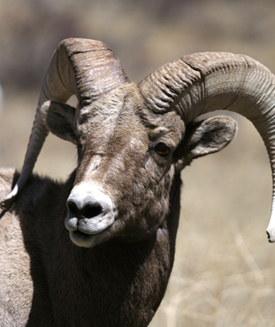 |
At left, a male bighorn sheep grazes off of Highway 34, less than a mile from the entrance to Rocky Mountain National Park. Below, elk roam freely in Estes Park and Rocky Mountain National Park. This picture was taken from our hotel, just steps from our doors. (Photos by David Sargent). |
Our morning started with a bird-watching trek in the valley at Moraine Park. Driving into the park, however, we encountered a herd of elk walking the streets of downtown Estes Park. While hundreds of elk enjoy the ranges of Rocky Mountain National Park, they’ve also made themselves a fixture in the small town just outside of it. (Visitors often capture these scenes on their video camera and cell phones. To see an example, simply do a YouTube search and you’ll see what I mean.)
The Rocky Mountain elk are some of the largest mammals in North America, second really only to moose. Males grow to more than 700 pounds and shed their characteristic large antlers every year.Their recent expansion in population has caused ecological problems in Rocky Mountain National Park and in Estes Park. They’ve destroyed groves of aspen trees from not enough migration and some have contracted Chronic Wasting Disease, which causes symptoms similar to mad cow disease.
“It used to be that wolves would hunt the elk, keep them migrating and maintain a healthy population,” said Kyle Patterson, interpretive ranger and public information officer for Rocky Mountain National Park. “But since the wolves have been gone, we’ve had to deal with some issues with the elk.”
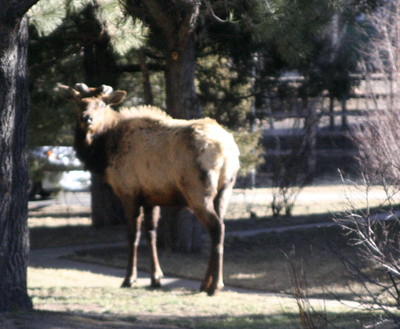 Passing the Beaver Meadows Visitor Center, we proceeded to Moraine Park via State Highway 36.
Passing the Beaver Meadows Visitor Center, we proceeded to Moraine Park via State Highway 36.
Our volunteer guide, Ron Harden, was a dentist from Loveland, Colo., and he led us on a hike for less than an hour, during which we saw two woodpeckers, a mallard duck pair, magpies and a red-tailed hawk flying up above the ridge line.
“The magpies are building their nests right now,” said Harden.
Magpies are illustriously smart and didn’t seem to notice us since they were so busy collecting sticks. The ducks weren’t too timid by our presence, either.
We also spotted greenback cutthroat trout in a steam in Moraine Park. This species was declared extinct by the Colorado Museum of Natural History in 1937 due to the introduction of competing trout species into their habitat. But, in 1957, a population was discovered in five streams of the Rocky Mountain National Park.
“The introduction of the brown trout diminished the [greenback’s] native population,” said Janis Newman, a 12-year volunteer in the park information office. “But we’ve been able to protect the greenback.”
Conservation efforts have since expanded populations to 19 streams as of 2006, and successfully upgraded the greenback’s status from endangered to threatened. Once the greenback cutthroat trout has self-sustaining populations in 22 streams, it will be taken entirely off of the endangered species list.
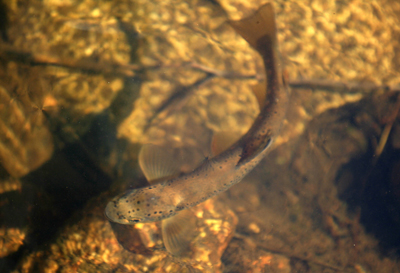 |
The greenback cutthroat trout was thought to be extinct from the 1930s until it was discovered to still dwell in five streams in Rocky Mountain National Park. Conservation efforts have nearly completely restored the population. |
Leaving the Moraine Park area, we passed more elk, grabbed a meal at Big Horn Restaurant in Estes Park and decided to head back into the park via State Highway 34. Coincidentally, less than a mile before reaching the Fall River Visitor Center, we spotted a herd of bighorn sheep grazing on the upper bank of the road, about one hundred feet from the shoulder. We hopped out to get a closer look and they didn’t seem to mind our presence one bit.
“From May to July, the bighorn will come down from the higher elevations into the meadows like Horseshoe Park to get needed minerals,” Newman said.
|
Above right, a magpie carries a stick through Moraine Park that will be used to build a nest. Below right, a pair of mallard ducks wade in a stream in Moraine Park. Male (left) and female (right) mallards usually pair together for breeding season. |
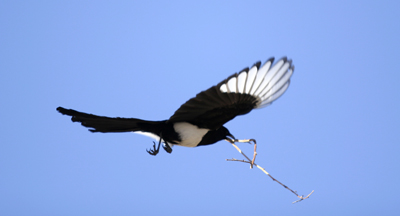
|
A bighorn ram’s horns can weigh up to 30 pounds and are most used in “ruts” with other rams to establish dominance and secure an ewe for mating.
The species that lives in Rocky Mountain National Park is relatively bigger than other bighorn sheep in America and is highly adapted to moving across steep and rocky terrain. Thankfully for us, the flock we spotted was more interested in eating grass than anything else.
We proceeded up Highway 34 into the park and headed for the snow cutoff at Trail Ridge Road. After paying a visit to Hidden Valley, we stopped at Many Parks Curve to take in the view and, in the rocks below the observation deck, there were three boisterous yellow-bellied marmots fighting over territory.
The yellow-bellied marmot is said to be the largest species of ground squirrel in the world. They’re closely related to ground hogs or wood chucks and they live in burrows underneath rocks as a defense against predators such as bears, coyotes, wolves, foxes and humans. One of their unofficial monikers is the “whistle pig” for the characteristic sound they make to warn others of nearby predators.
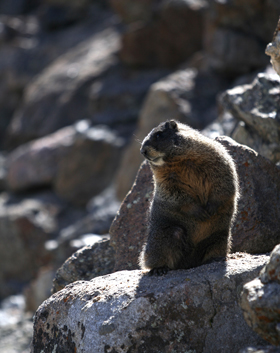 |
This yellow-bellied marmot perches on a rock at Many Parks Curve on Trail Ridge Road. Just minutes before, this marmot attacked another marmot, which aptly retreated |
“The marmots are pretty common to see on all of the trails higher up,” Newman said. “They’re curious animals.”
As the day winded down, we decided to head back into Estes Park and, yet again, passed the Estes Park elk.
“They go wherever they want, whenever they want,” Newman said about the park’s animals. “I once spotted a moose, right on the trail I was on,” she said. “Thankfully, I’ve never seen a bear.”
If You Go Wildlife Spotting
- Magpie can be spotted in Moraine Park in springtime as they build their nests.
- Ducks can be spotted in the various riparian areas of the park.
- Greenback trout can be spotted in Bear Lake, past the, Moraine Park Visitor Center
- Bighorn sheep can be spotted on the upper bank of Highway 34 near the park borders, or in some of the larger meadows in early summer. They can also be observed off of Crater Lake Trail in August, during their breeding season.
- Elk can be spotted in lower meadows, such as Moraine Park, during the day. They can also be found on golf courses in Estes Park.
- Yellow-bellied marmots can be seen on most higher-elevation trails or on rocks cliffs during the daytime.
- When spotted, moose are found on the western side of the park in riparian areas.

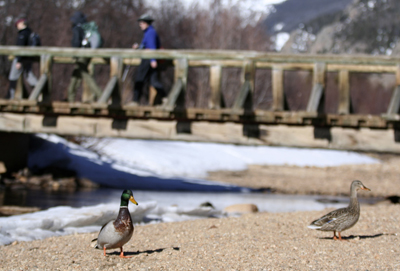
Comments are Closed